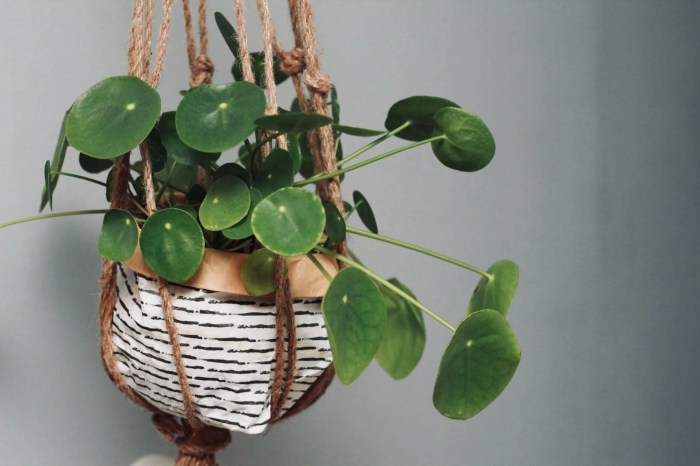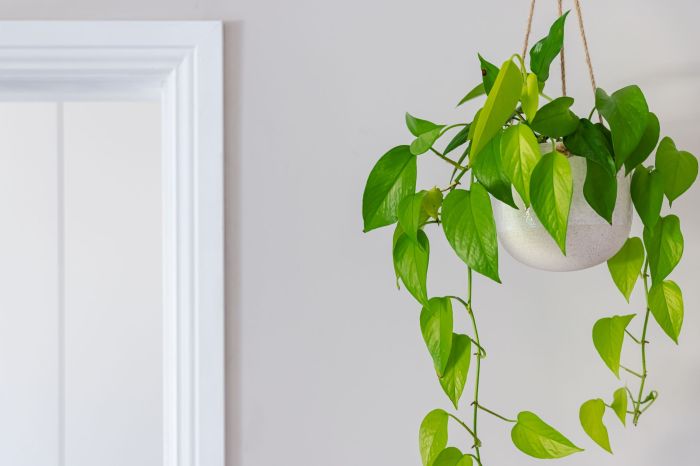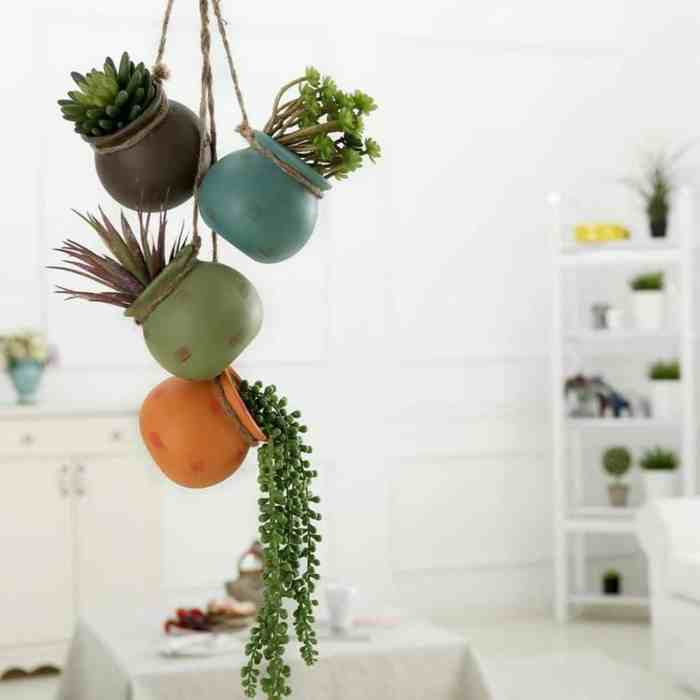Common hanging indoor plants have gained immense popularity due to their aesthetic appeal, ease of care, and ability to enhance indoor air quality. From trailing vines to lush ferns, these versatile plants add a touch of nature and elegance to any space.
Hanging plants bring a unique dimension to interior design, creating a sense of ambiance and visual interest. They contribute to air purification, removing harmful toxins and improving overall air quality.
Popular Indoor Hanging Plants

Hanging plants have become increasingly popular due to their ability to add a touch of greenery and elegance to any indoor space. They are particularly well-suited for small apartments or rooms with limited floor space, as they can be suspended from the ceiling or placed on high shelves.
These plants are not only aesthetically pleasing but also easy to care for, making them a great choice for both experienced and novice plant owners. They are generally adaptable to a wide range of light conditions and require minimal watering, making them ideal for busy individuals or those who travel frequently.
Varieties of Hanging Plants
- Spider Plant (Chlorophytum comosum):Known for its long, trailing stems with variegated leaves, the spider plant is a popular choice for hanging baskets. It is easy to propagate and can tolerate low light conditions.
- Pothos (Epipremnum aureum):Also known as the devil’s ivy, pothos is a hardy plant with heart-shaped leaves that come in a variety of colors, including green, yellow, and white. It is tolerant of neglect and can thrive in both bright and low light.
- String of Pearls (Senecio rowleyanus):This unique plant features long, trailing stems with pea-sized, bead-like leaves. It prefers bright, indirect light and well-draining soil.
- Burro’s Tail (Sedum morganianum):With its cascading stems and plump, blue-green leaves, burro’s tail is a striking addition to any hanging planter. It requires bright, indirect light and infrequent watering.
- Air Plant (Tillandsia spp.):Air plants are unique in that they do not require soil to grow. They absorb nutrients and moisture from the air and prefer bright, indirect light.
Aesthetics and Benefits of Hanging Plants
Hanging plants are not just a decorative element but also offer several aesthetic and practical benefits. They add a touch of greenery and vibrancy to any indoor space, creating a more inviting and relaxing ambiance.
Visual Interest and Ambiance
Hanging plants break the monotony of vertical spaces, adding visual interest and depth to a room. They draw the eye upward, creating a sense of height and spaciousness. The cascading foliage and intricate patterns of hanging plants create a captivating visual display that can transform a dull corner into a focal point.
Air Purification
Many hanging plants have air-purifying properties. They absorb harmful toxins and pollutants from the air, improving indoor air quality. Studies have shown that plants like spider plants, ferns, and peace lilies can effectively reduce levels of benzene, formaldehyde, and other volatile organic compounds (VOCs).
Care and Maintenance of Hanging Plants

Maintaining the health and beauty of hanging plants requires regular care and attention. Proper watering, fertilizing, and pruning are essential for their growth and well-being. Additionally, understanding the specific lighting requirements for each species is crucial for optimal growth.
Watering
Hanging plants have varying water needs, depending on the species and the environmental conditions. In general, it is best to water them when the soil feels dry to the touch. Overwatering can lead to root rot and other problems, so it is important to avoid keeping the soil constantly wet.
Fertilizing, Common hanging indoor plants
Fertilizing hanging plants regularly helps to promote healthy growth and flowering. A balanced liquid fertilizer can be applied monthly during the growing season. Avoid over-fertilizing, as this can damage the roots.
Pruning
Pruning hanging plants helps to maintain their shape and encourage new growth. Remove any dead or damaged leaves or stems, and trim back any excessively long or leggy growth. Pruning can also be used to control the size and shape of the plant.
Lighting
Different species of hanging plants have different lighting requirements. Some prefer bright, indirect light, while others can tolerate lower light levels. It is important to research the specific lighting needs of each species and provide them with the appropriate environment.
Common Problems
Overwatering, pests, and diseases are common problems that can affect hanging plants. Overwatering can be prevented by allowing the soil to dry out between waterings. Pests can be controlled by using insecticidal soap or other natural remedies. Diseases can be prevented by providing proper ventilation and avoiding overwatering.
Design Considerations for Hanging Plants

Hanging plants are not just space-savers; they also add a touch of greenery and life to any room. However, choosing the right hanging planter and placing it strategically can make all the difference in creating a visually appealing and balanced arrangement.
Choosing the Right Hanging Planter
The type of hanging planter you choose should complement the plant’s size, shape, and growth habit. For instance, trailing plants like pothos or spider plants look stunning in macrame or chain hangers, while succulents and air plants thrive in geometric or ceramic planters.
Plant Placement
Proper plant placement is crucial for both aesthetics and plant health. Consider the amount of natural light available in the room and choose plants that are suited to those conditions. Suspend plants at varying heights to create a dynamic display and avoid overcrowding.
Common hanging indoor plants such as pothos, spider plants, and ferns bring life and greenery to any space. For smaller areas, consider opting for best small hanging plants like the trailing jade or string of pearls. These compact varieties add a touch of elegance without overwhelming the room, making them ideal for apartments, dorm rooms, or any space where vertical gardening is desired.
Common hanging indoor plants not only beautify the surroundings but also purify the air, creating a healthier living environment.
Incorporating Hanging Plants into Room Styles
Hanging plants can enhance any room style, from modern to traditional. In contemporary spaces, sleek metal or glass planters with trailing plants add a touch of elegance. In bohemian settings, macrame hangers and lush greenery create a cozy and inviting atmosphere.
For a touch of vintage charm, opt for hanging baskets or wrought iron planters with trailing ivy or ferns.
DIY Projects and Creative Uses for Hanging Plants

DIY hanging planters offer a unique way to showcase your plants and add a touch of creativity to your home decor. You can create them using a variety of materials such as macrame, rope, or even repurposed objects like tin cans or baskets.
Hanging plants can be displayed in a variety of ways to create a stunning visual impact. You can use plant shelves to create a vertical garden, or use trellises to create a living wall. You can even suspend hanging plants from the ceiling to create a whimsical and eye-catching display.
Macrame Hanging Planters
Macrame hanging planters are a popular choice for their intricate and bohemian style. You can create your own macrame hanging planters using a variety of knots and cords. There are many tutorials available online that can teach you how to make your own macrame hanging planters.
Among common hanging indoor plants, there are some that thrive in low light conditions, making them ideal for bedrooms. For a touch of greenery in dimly lit spaces, consider exploring best hanging plants for bedroom low light . These plants not only add a vibrant touch to your room but also help purify the air.
From trailing pothos to elegant spider plants, there are plenty of low-maintenance options to choose from, ensuring you can enjoy the beauty of nature even in low-light areas.
Rope Hanging Planters
Rope hanging planters are another popular option for DIY enthusiasts. They are easy to make and can be customized to fit any style of decor. You can use any type of rope to make a rope hanging planter, but jute or sisal rope is a good choice for its durability and natural look.
Common hanging indoor plants, such as pothos and spider plants, add a touch of greenery to any room. For those looking to add a trailing element to their indoor space, consider the best trailing plant . Trailing plants can cascade over shelves or hang from the ceiling, creating a lush and inviting atmosphere.
They are a great choice for small spaces or for adding a touch of elegance to a larger room. Common hanging indoor plants, such as ferns and ivy, are also easy to care for, making them a great choice for both experienced and novice plant enthusiasts.
Repurposed Object Hanging Planters
You can also use repurposed objects to create unique and stylish hanging planters. For example, you can use tin cans, baskets, or even old light fixtures to create hanging planters. Just be sure to clean and prepare the object before planting.
Closing Notes: Common Hanging Indoor Plants

Incorporating common hanging indoor plants into your home is a simple and effective way to enhance its beauty and well-being. With proper care and maintenance, these plants will thrive, providing years of enjoyment and creating a healthier, more inviting living space.
FAQs
What are the most common types of hanging indoor plants?
Spider plants, pothos, ferns, trailing succulents, and ivy are among the most popular hanging indoor plants.
How often should I water hanging plants?
Water hanging plants when the soil feels dry to the touch, but avoid overwatering.
What are the best lighting conditions for hanging plants?
Most hanging plants prefer bright, indirect light, but some species can tolerate lower light conditions.